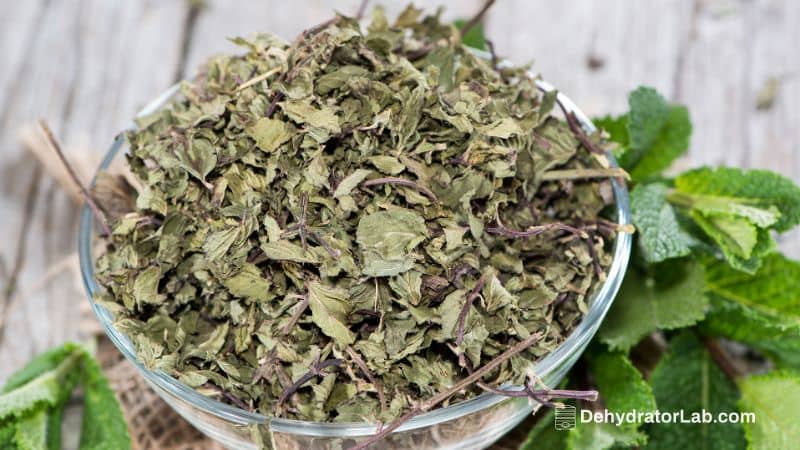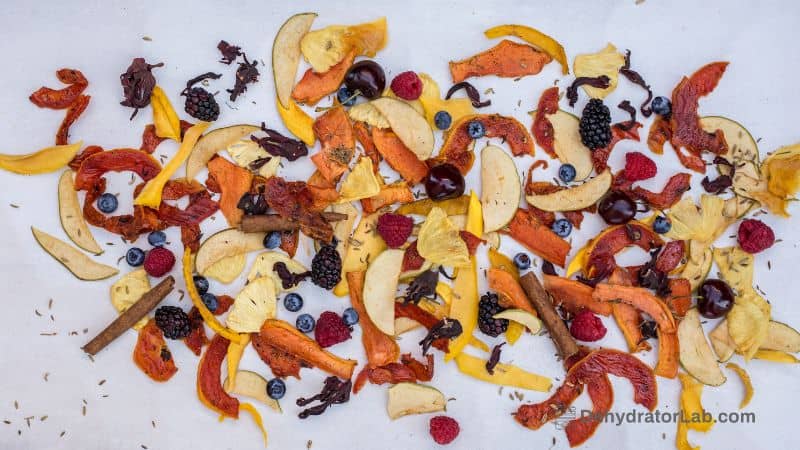Are you overflowing with citrus fruits and unsure of how to preserve them? Dehydrating is an excellent option! From oranges to lemons, limes, kumquats, and even grapefruit – the possibilities are endless.
In this guide, we’ll teach you how to dehydrate citrus fruits, a complete step-by-step walk through the process of dehydrating citrus fruits, and even share a DIY citrus cleaner recipe.
Ready? Let’s get started!

As an Amazon Associate, I earn from qualifying purchases. If you make a purchase after clicking on a link I may earn a small commission at no extra cost to you if items are purchased.
In this article:
Equipment & Prep
- Citrus fruits
- Vinegar
- Water
- Sharp knife or mandolin
- Cutting glove
- Dehydrator
- Tray mats or mesh screens
- Parchment paper or baking paper
The Anatomy of Citrus Fruits
There are three parts to a citrus fruit: the zest, the pith, and the flesh.
- Zest: The outermost layer of citrus fruits is great for adding flavor to various dishes.
- Pith: This white part can be quite bitter, but it can be removed from the dried fruit if desired.
- Flesh: The juicy part of the fruit that we typically eat.
Prepping Your Citrus Fruits (Cleaning)
First, we’ll soak the citrus pieces in a 50/50 vinegar and water solution. This step is essential as it ensures the cleanliness of the fruits and removes any dirt and bacteria.
Trust me, you’ll want to be generous with the vinegar, as we’ll be using the entire fruit.
Cutting Techniques
Now, let’s talk about cutting the citrus. I recommend using a sharp serrated bread knife or a mandolin, which will make slicing easier because it easily cuts through the citrus skin.
Don’t forget to wear a safety glove while cutting to protect your hands!
Here is breakdown of various citrus fruits slicing techniques:
Cutting Techniques
- Limes: They can be easily sliced with a sharp knife.
- Lemons: Larger lemons may require a mandolin for easier slicing.
- Blood Oranges: These oranges have a unique, red juice and can be sliced like regular oranges.
- Grapefruit: Larger grapefruits may need to be sliced with a knife instead of a mandolin.
Dehydrating Your Citrus Fruits
Now that your citrus fruits are sliced, it’s time to place them on your dehydrator trays. Arrange the fruit evenly across the trays. You can use a mesh screen, parchment paper, or a tray mat to prevent sticking.

Remember that taste is crucial – if the fruit tastes off before dehydrating, it’ll taste off after as well, so remember to taste your fruit before drying it, as the flavors will intensify during dehydration. If it tastes bad going in, it’ll likely taste bad coming out.
The same goes for bitterness: if the fruit is bitter, to begin with, expect that bitterness to be even more pronounced once it’s dried.
Dehydration Duration and Temperature
Dehydrate your citrus fruits at 125°F or lower for 18 to 36 hours. The duration depends on your machine, local weather, and slice thickness. Avoid higher temperatures, as they can cause browning.

Once the dehydrating process is complete, you’ll be left with a beautiful array of dried citrus slices. Not only do they make for stunning food art, but they also serve as a fantastic way to use up excess fruit and minimize waste in your home.
Tips and Tricks for Dehydrating Citrus and Repurposing Peelings
Making DIY Citrus Vinegar Cleaner
Don’t throw away those citrus peelings! Instead, turn them into a homemade citrus cleaner by placing the peels in a jar, covering them with vinegar, and letting them steep for two weeks to create a natural cleaner.
This cleaner is perfect for sprucing up your kitchen and bathroom.
Zesting
To dehydrate just the zest, you can zest a lot of fruit before drying the insides. For an easier way, use a microplane zester to create little shavings of zest.

Avoid drying them in a dehydrator as they will blow around.
Instead, place them in a bowl, cover them with something, and allow them to dry on their own. You can also use a peeler or a box grater, but be careful not to get too far into the pith as it can be extremely bitter.
Segmenting
Some people like to dehydrate segments by slicing the fruit, removing the rind, and eating the insides when dry. To make the drying process more efficient, make slices in the membrane to allow moisture to escape.
Alternatively, you can remove the membrane by hand or use a pectic enzyme to eat it away. You can also cut the segments in half to make them thinner and dry faster.
Storage
Properly dehydrated citrus can last up to a year or more. To store, use airtight containers like glass jars or resealable plastic bags. Label them and store them in a cool, dry place away from sunlight.
FAQ’s
Can you dehydrate citrus fruit?
Yes, you can dehydrate citrus fruits, including oranges, lemons, limes, and grapefruits.
How long does citrus take in a dehydrator?
Dehydrating citrus fruits typically takes 8-12 hours at 125-135°F (52-57°C).
How long will dehydrated citrus last?
Dehydrated citrus can last up to a year if stored in airtight containers, in a cool, dark, and dry place.
What is dehydrated citrus good for?
Dehydrated citrus can be used for flavoring drinks, garnishes, baking, potpourri, or as a snack.
Do dehydrated oranges go mouldy?
Dehydrated oranges can go mouldy if not properly dried or stored, or if exposed to moisture.
Why did my dehydrated lemons turn brown?
Dehydrated lemons may turn brown due to oxidation, over-drying, or uneven slicing. Ensure even slicing and proper airflow in the dehydrator.
Is a dehydrator better than an oven for oranges?
A dehydrator is generally better than an oven for oranges, as it provides consistent temperature and airflow, ensuring even drying.
Should dehydrated citrus be sticky?
Dehydrated citrus should not be sticky; if it is, it may not be fully dried, and should be returned to the dehydrator.
Can you eat dehydrated lemons?
Yes, you can eat dehydrated lemons, although they are often used for flavoring rather than as a standalone snack.
How do you prepare citrus fruits for dehydration?
To prepare citrus fruits for dehydration, wash the fruit, remove any labels, and slice thinly, about 1/8 to 1/4 inch thick.
Can I use a dehydrated lime in place of a fresh lime?
Dehydrated limes can be used as a substitute for fresh limes in some recipes, but the flavor and texture may be slightly different.
How do I store dehydrated citrus fruits?
Store dehydrated citrus fruits in airtight containers, away from direct sunlight, in a cool, dark, and dry place.
Can I rehydrate dehydrated citrus fruits?
Rehydrating dehydrated citrus fruits is not common due to their altered texture, but they can be used in recipes that call for citrus zest or infused in liquids for flavor.
What are the benefits of dehydrating citrus fruits?
Dehydrating citrus fruits extends their shelf life, reduces waste, and provides a concentrated source of flavor for various applications.
Can I dehydrate citrus fruits in an oven if I don’t have a dehydrator?
Yes, you can dehydrate citrus fruits in an oven set to the lowest temperature, but it may take longer and produce less consistent results.
Conclusion
Dehydrating citrus fruits is a fantastic way to preserve your excess fruits while creating unique food art and reducing waste. Plus, you can use the leftover peels to make an eco-friendly citrus cleaner.
Give it a try and enjoy the delicious and beautiful results!



